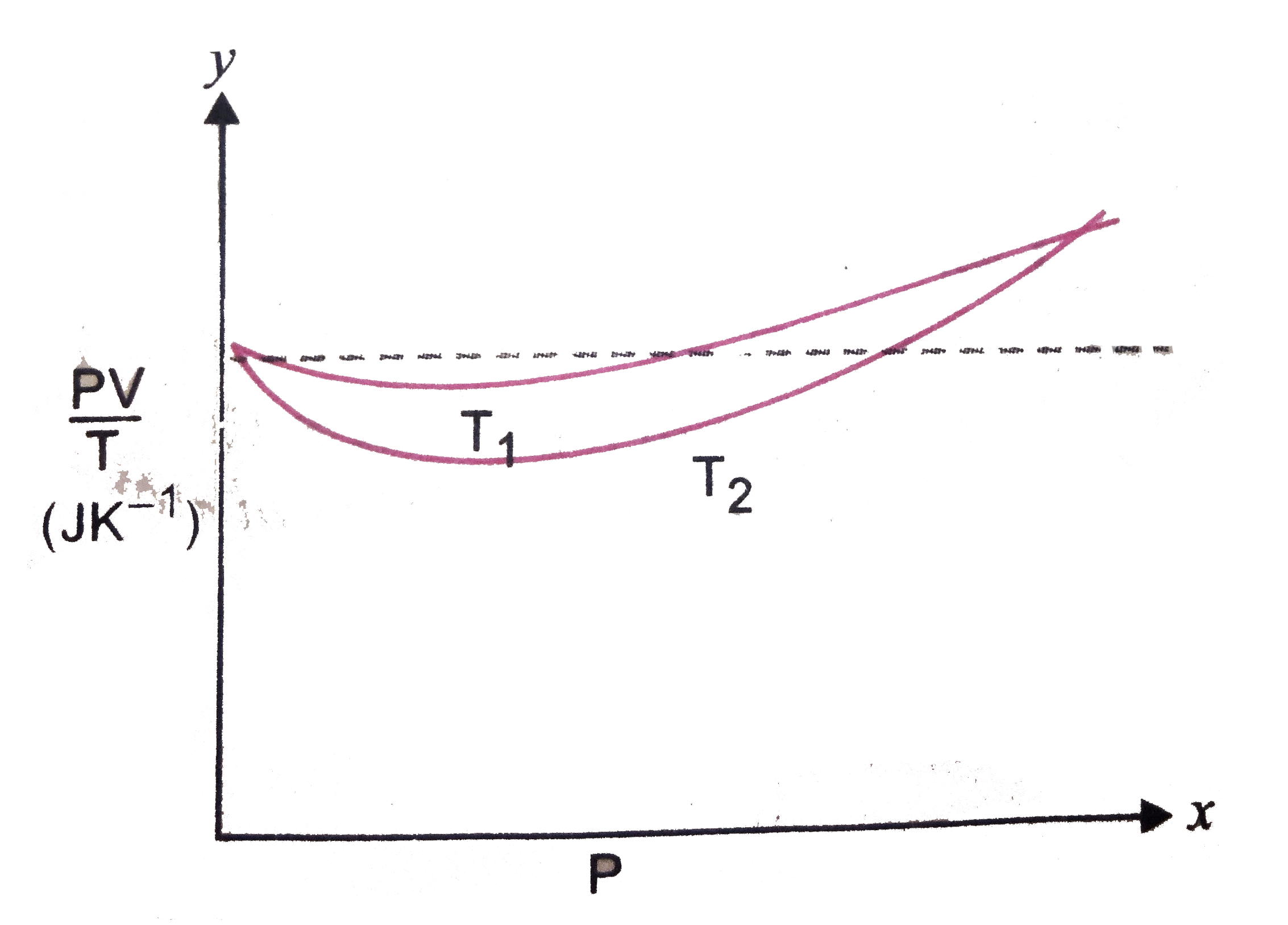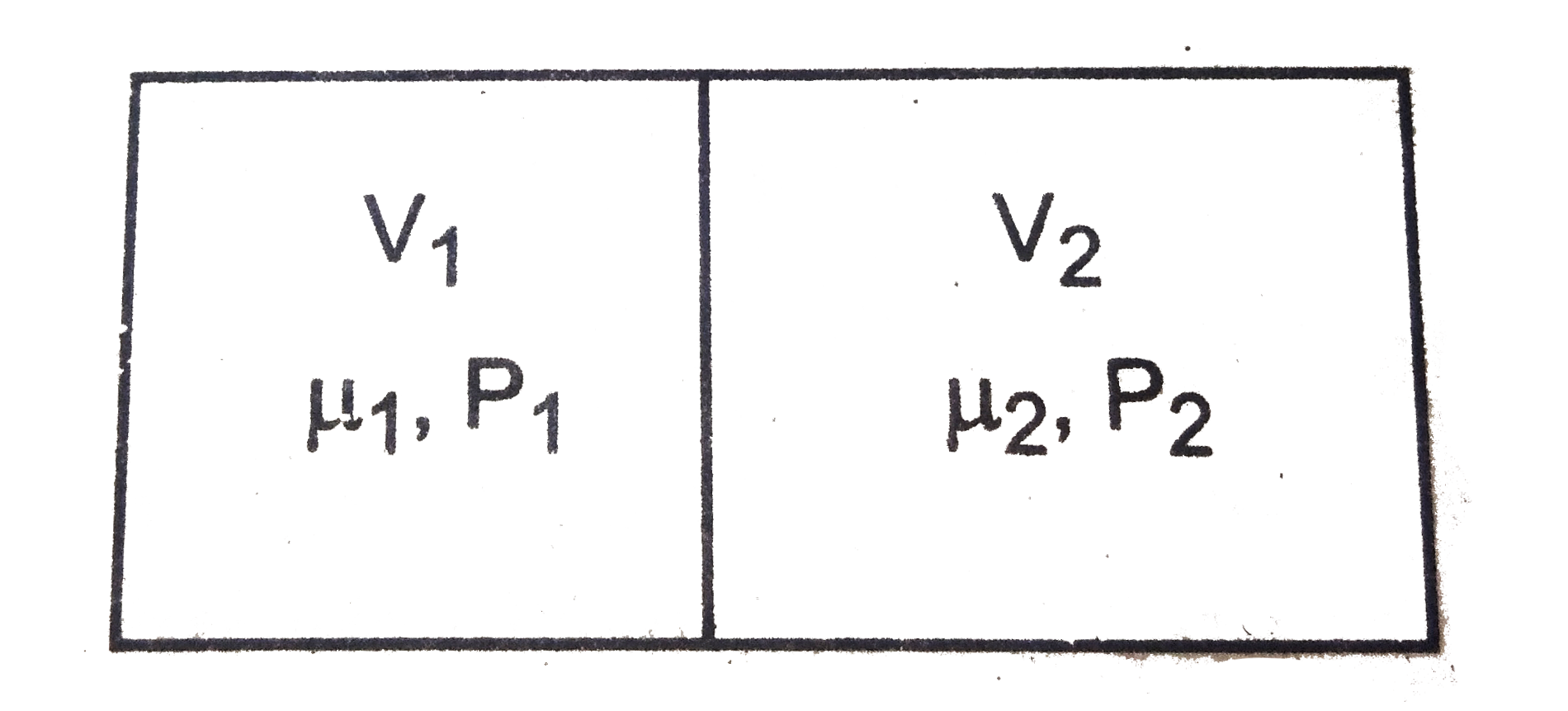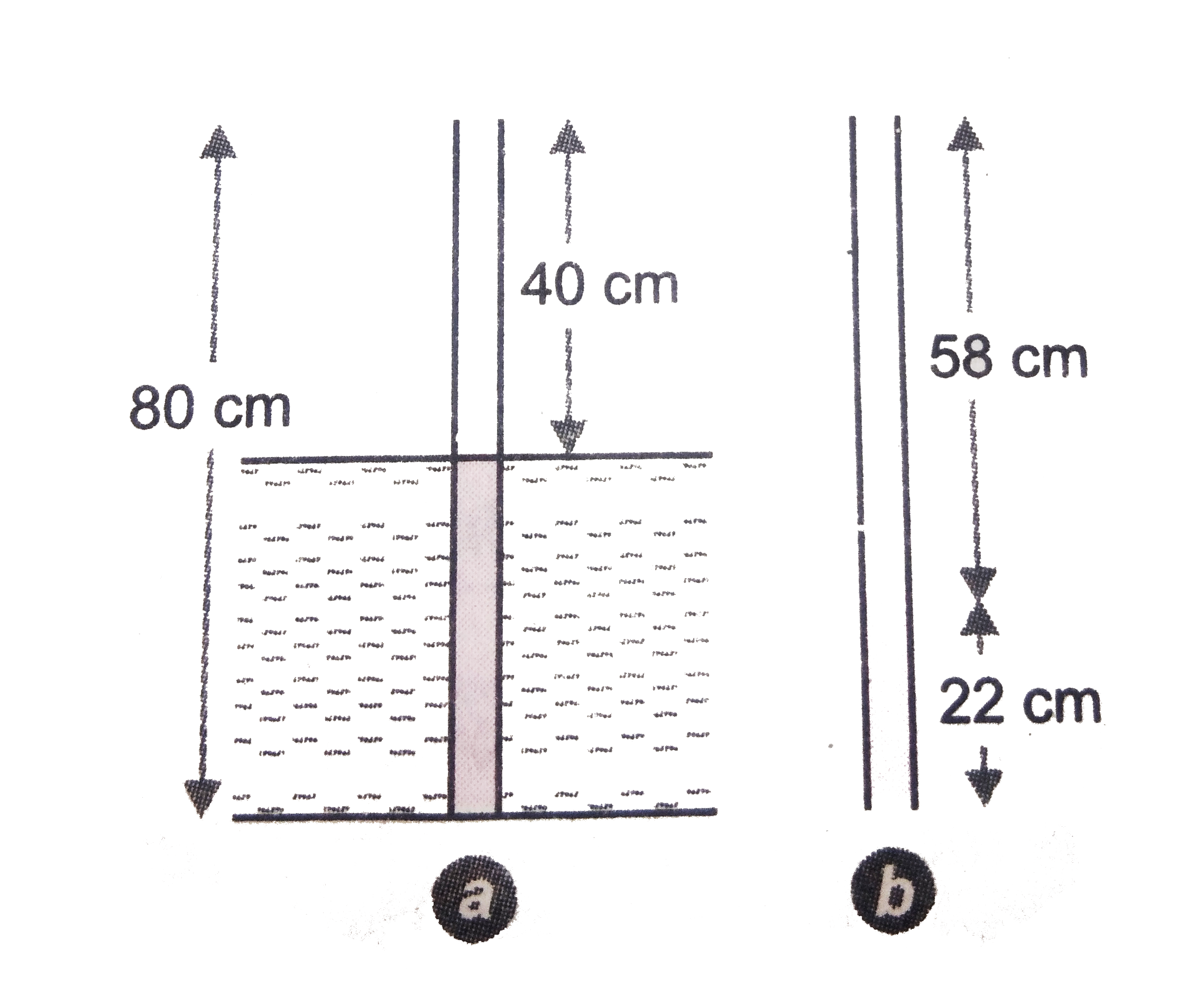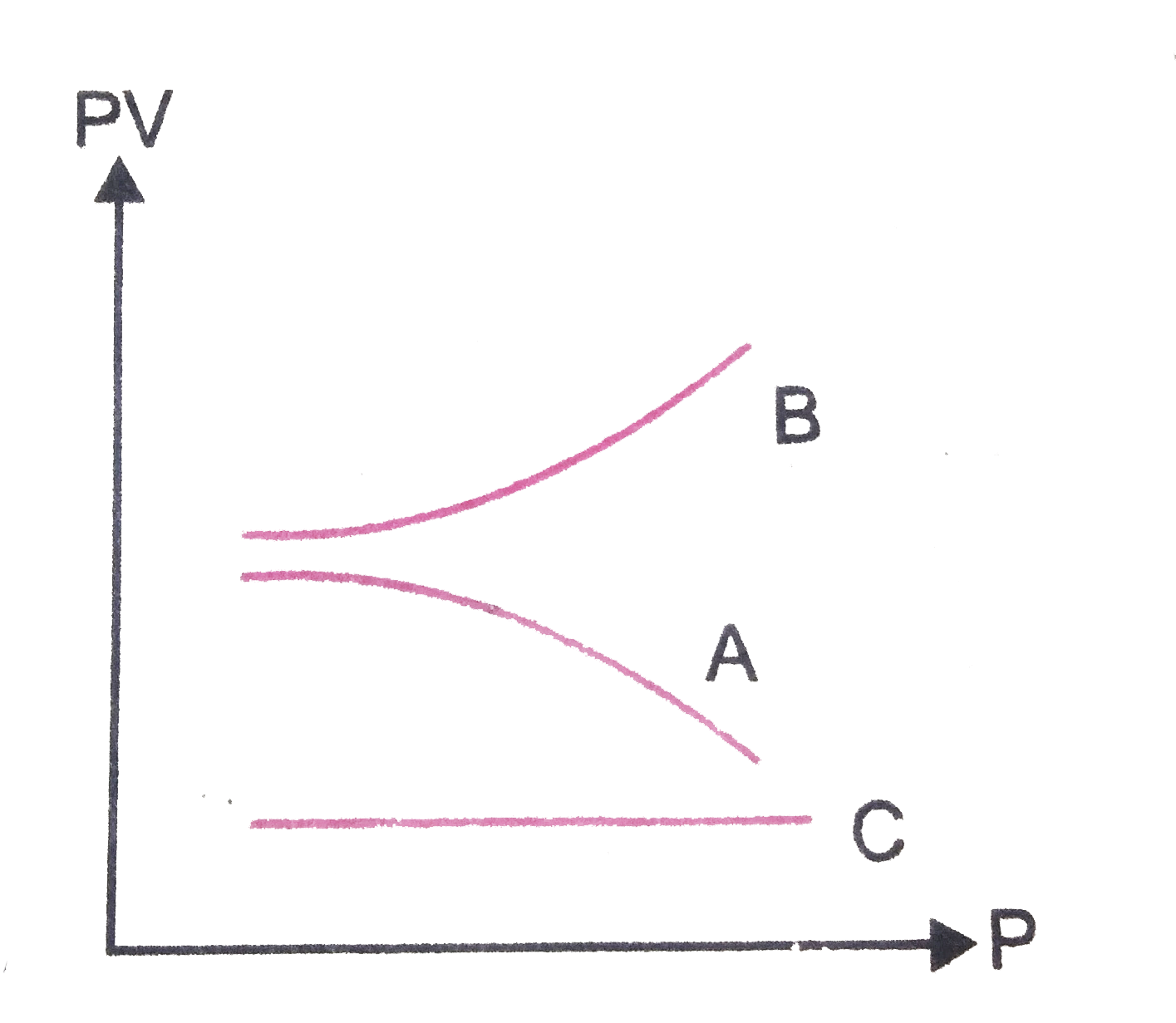Solved Examples from PRADEEP PHYSICS (HINGLISH) BEHAVIOUR OF PERFECT GAS & KINETIC THEORY for Class 11
| Class 11 | PHYSICS |
| Chapter | BEHAVIOUR OF PERFECT GAS & KINETIC THEORY |
| PRADEEP PHYSICS (HINGLISH) | Solved Examples |
| Medium | English |
| Academic Year | 2023-2024 |
Question 1
One metre long tube, closed at both ends, is lying horizontally. A mercurry column of length 0.1 m is filled in its middle and in rest two parts air is filled at atmospheric pressure. What will be the displancement of the mercurry column when the tube is turned to vertical position ? Atmospheric pressure = 0.76 m of Hg.View SolutionQuestion 10
The density of water is 1000kgm−3. The density of water vapour at 100∘C and 1 atmospheric pressure is 0.6kgm−3. The volume of a molecule multiplied by the total number gives what is called, molecular volume. Estimate the ratio (or fraction) of the molecular volume to the total volume occupied by the water vapour under the above conditions of temperature and pressure.View SolutionQuestion 13
A gas at 27∘C in a cylinder has a volume of 4 litre and pressure 100Nm−2.
(i) Gas is first compressed at constant temperature so that the pressure is 150Nm−2 . Calculate the change in volume.
(ii) It is then heated at constant volume so that temperature becomes 127∘C. Calculate the new pressure.View SolutionQuestion 14
A closed container of volume 0.02m3contains a mixture of neon and argon gases, at a temperature of 27∘C and pressure of 1×105Nm−2. The total mass of the mixture is 28g. If the molar masses of neon and argon are 20and40gmol−1 respectively, find the masses of the individual gasses in the container assuming them to be ideal (Universal gas constant R=8.314J/mol−K).View SolutionQuestion 16
A vessel contains two non-reactive gases neon (monoatomic) and oxygen (diatomic). The ratio of their partial pressures is 3:2. Estimate the ratio of
(i) number of molecules, and
(ii) mass density of neon and oxygen in the vessel.
Atomic mass of neon = 20.2 u, and molecular mass of oxygen = 32.0 u.View SolutionQuestion 25
A flask contains argon and chlorine in the ratio 2:1 by mass. The temperature of the mixture is 27∘. Obtain the ratio of
(i) average kinetic energy per molecule, and
(ii) root mean square speed of the molecules of two gases.
Atomic mass of argon = 39.9 u, Molecular mass of chlorine = 70.9 u.View SolutionQuestion 27
(a) When a molecule (or an elastic ball) hits a (massive) wall, it rebounds with the same speed. When a ball hits a massive bat held firmly, the same thing happens However, when the bat is moving towards the ball, the ball rebounds with a different speed. Does the ball move faster or slower?
(b) When gas in a cylinder is compressed by pushing in a piston. Its temperature rises. Guess at an explanation of this in terms of kinetic theory using (a) above
(c) What happens when a compressed gas pushes a piston out and expands. What would you observe?
(d) Sachin Tendulkar uses a heavy cricket bat while playing. Does it help him in any way?View SolutionQuestion 31
A vessel A contains hydrogen and another vessel B whose volume is twice that of A contains same mass of hydrogen at same temperature. Compare
(i) average KE of hydrogen and oxygen molecule.
(ii) root mean square speeds of molecules
(iii) pressure of gases in A and B.
Molecular weight of hydrogen and oxygen are 2 and 32 respectively.View SolutionQuestion 43
A gaseous mixture enclosed in a vessel consists of one gram mole of a gas A with γ=(53) and some amount of gas B with γ=75 at a temperature T.
The gases A and B do not react with each other and are assumed to be ideal. Find the number of gram moles of the gas B if γ for the gaseous mixture is (1913).View SolutionQuestion 134
An open glass tube is immersed in mercury in such a way that a lenth of 8cm extends above the mercury level. The open end of the tube is then closed and sealed and the tube is raised vertically up by additional 46cm. What will be length of the air column above mercury in the tube now?
(Atmosphere pressure =76cm of Hg)View SolutionQuestion 135
A closed container of volume 0.02m3contains a mixture of neon and argon gases, at a temperature of 27∘C and pressure of 1×105Nm−2. The total mass of the mixture is 28g. If the molar masses of neon and argon are 20and40gmol−1 respectively, find the masses of the individual gasses in the container assuming them to be ideal (Universal gas constant R=8.314J/mol−K).View SolutionQuestion 136
A column of mercury of 10cm length is contained in the middle of a narrow horizontal 1m long tube which is closed at both the ends. Both the halves of the tube contain air at a pressure of 76 cm of mercury. By what distance will the column of mercury be displaced if the tube is held vertically?View SolutionQuestion 145
Fig shows of PV/T versus P for 1.00×10−3kg of oxygen gas at two different temperatures.
(a) What does the dotted plot signify ?
(b) Which is true : T1<T2orT2<T1?
( c) What is the value of PV/T where the curves meet on the Y-axis ?
(d) If we obtained similar plot for 1.00×10−3kg of hydrogen, would we get the same value of PV/T at the point where the curves meet on the y-axis ? If not, what mass of hydrogen yield the same value of PV/T (for low pressure high temperature region of the plot) ? (Molecular mass of H=2.02u, of O=32.0u,R=8.31Jmol−1K−1
 View Solution
View SolutionQuestion 146
An oxygen cylinder of volume 30 litres has an initial gauge pressure of 15 atm. And a temperature of 27∘C. After some oxygen is withdrawn from the cylinder, the gauge pressure drops to 11 atm. And its temperature drops to 17∘C. Estimate the mass of oxygen taken out of the cylinder. (R=8.1Jmole−1K−1, molecular mass of O2=32u).View SolutionQuestion 150
Three vessel of equal capacity have gases at the same temperature and pressure. The first vessel contains neon (monoatomic), the second contains chlorine (diatomic), and the third contains uranium hexafluoride (polyatomic). Do the vessels contains equal number of respectice molecules ? Is the root mean square speed of molecules the same in the three cases ? If not, which case is vrms the largest?View SolutionQuestion 152
Estimate the mean free path and collision frequency of a nitrogen molecule in a cylinder containing nitrogen at 2 atm. And temperature 17∘. Take the radius of a nitrogen molecule to be roughly 1.0Å. Compare the collision time with the time molecule moves freely between two successive collisions. (Molecular mass of nitrogen = 28.0 u).View SolutionQuestion 155
A gas in equilibrium has uniform density and pressure throughout its volume. This is strictly true only if there are no external influences. A gas column under gravity, for example, does not have uniform density (and pressure). As you might expect, its density decreases with height. the precise dependence is given by the so called law of atmosphere' : n2=n1exp[−mg(h2−h1)/kBT] where, n1.n2 refer to number density at height h1 and h2 respectively. use this relation to derive the equation for sedimentation equilibrium of a suspension in a liquid columns:
n2=n1 exp [−mgNA(roh−roh′)(h2−h1)/(rohRT)]
where, roh is the density of the suspended particle, and roh' that of surrounding medium. [NA is Avogadro's number, and R is the universal gas constant].View SolutionQuestion 162
The container shown in Fig. 9(EP).6 has two chambers, separated by a partition, of volumes V1=2.0litreandV2=3.0litre. The chambers contains μ1=4.0andμ2=5.0moles of a gas at pressures p1=1.00atmandp2=2.00atm. calculate the pressure after the partition is removed and the mixture attains equilibrium.
 View Solution
View SolutionQuestion 164
We have 0.5 g of hydrogen gas in a cubic chamber of size 3 cm kept at NTP. The gas in the chamber is compressed keeping the temperature constant till a final pressure of 100 atm. Is one justified in assuming the ideal gas law in the final state ? (Hydrogen molecules can be consider as spheres of radius 1Å).View SolutionQuestion 170
Ten small planes are flying at a speed of 150km/h in total darkness in an air space that is 20×20×1.5km3 in volume. You are in one of the planes, flying at random within this space with no way of knowing where the other planes are, On the average about how long a time will elapse between near collision with your plane. Assume for this rough computation that a safety region around the plane can be approximately by a sphere of radius 10 m.View SolutionQuestion 172
Consider a rectangular block of wood moving with a velocity v0 in a gas at temperature T and mass density p. Assume the velocity is along x-axis and the are of cross-section of the block perpendicular to v0 is A. show that the drag force on the block is 4rAv0√kTm where,m is the mass of the gas molecule. View SolutionQuestion 173
Calculate the mean free path of nitogen at 27∘C when pressure is 1.0 atm. Given, diameter of nitogen molecule = 1.5Å,k=1.38×10−23JK−1. If the average speed of nitrogen molecules is 675ms−1, find the time taken by the molecule between two successive collsions and the frequency of collisions. View SolutionQuestion 176
A moles of a monoatomic ideal gas are at pressure 3×105Nm−2 and temperature 100K (state A, say). Is is head heated isobarically to temperature 400K (state B, say). Next it undergoes isothermal expansion to pressure 1×105Nm−2 (state C). It is then cooled isobarically to 100 K (state D). Finally, it is compressed isothermal to returm to its initial state A. Draw P-T : P-V and V-T diagrams for the whole process. View SolutionQuestion 182
An ideal gas or a perfect gas is that which strictly obeys the gas laws (such as Boyle's Law, Charle's Law etc.) Two essential characteristics of an ideal gas are :
(i) size of molecule of an ideal gas is zero.
(ii) There is no force of attraction or reputation amongst the moleculess of an ideal gas.
In view of this, no real gas is perfect.
Read the above passage and answer the following questions :
(i) Under what conditions do same real gases behave as nearly perfect gases ?
What does this concept imply in day to day life ?View SolutionQuestion 183
According to kinetic theory, every gas consists of a very large number of molecules, which are in a state of incessant random motion. They move in all directions with different speeds and obey Newton's law of motion. The molecules do not exert any force of attraction or repulsion on one another except during collision.
Read the above passage and answer the following questions :
(i)What is the cause of pressure exerted by the gas ?
(ii) What values of life do you learn from the kinetic theory ?View SolutionQuestion 184
As in known, the pressure exerted by a gas is due to continuous bombardment of gas molecules against the walls of the container. The expression for pressure is P=13(roh)C2, where (roh) is density of the gas and C is root mean square velocity of the gas molecules.
Read the above passage and answer the following questions :
(i) What is the root mean square velocity of hydrogen molecules at STP? Given density of hydrogen at STP is 0.09kg/m3.
How is this concept related in day to day life ?View SolutionQuestion 185
According to kinetic theory of gases, absolute temperature of a gas is directly proportional to the average kinetic energy of translation per molecules to the gas. Zeroth law of thermodynamics established that temperature is the obly physical quantity that determines whether a given system is in thermal equilibrium with another system. heat flows from a system at higher temperatures to another system at lower temperature till their temperatures becomes equal. temperature corresponds to level in case of liquids, pressure in case of gases potential in case of electricity.
Read the above passage and answer the following questions :
(i) The absolute temperature of a gas is increased three times. what will be the increase in rms velocity of gas molecules ?
What values of life do you learn this concept of temperature ?View SolutionQuestion 186
Accordig to Law of equipartition of energy, for any dynamical system in thermal equilibrium, the total energy in distributed equality amongst all the degrees of freedom. The energy associated with each molecule per degree of freedom is 12kBT where kB is Boltzmann constant and T is temperature of the system. the law emphasises that in thermal equilibrium, at temperature T, each more of energy : translation, rotational and vibrational, contribute an average energy equal 12kB⋅T
Read the above passage and answer the following questions :
(i) What is the internal energy of one gram mole of a polyatomic gas having an degree of freedom ?
(ii) What value of life do you learn from this law ?View Solution
All Exercises from PRADEEP PHYSICS (HINGLISH) Class 11 PHYSICS BEHAVIOUR OF PERFECT GAS & KINETIC THEORY
- ASSERTION - REASON TYPE QUESTIONS
- FILL IN THE BLANKS
- INTEGER TYPE QUESTIONS
- MULTIPLE CHOICE QUESTIONS-I
- MULTIPLE CHOICE QUESTIONS-II
- MULTIPLE CHOICE QUESTIONS-III
- PROBLEMS FOR PRACTICE
- VALUE BASED QUESTIONS
- ADVANCE PROBLEM FOR COMPETITIONS
- CONCEPTUAL PROBLEMS
- CURIOSITY QUESTION
- HIGHER ORDER THINKING SKILLS QUESTIONS
- LONG ANSWER QUESTIONS
- NCERT QUESTIONS
- SAMPLE PROBLEM
- SHORT ANSWER QUESTIONS
- SOLVED EXAMPLES
- VERY SHORT ANSWER QUESTIONS



